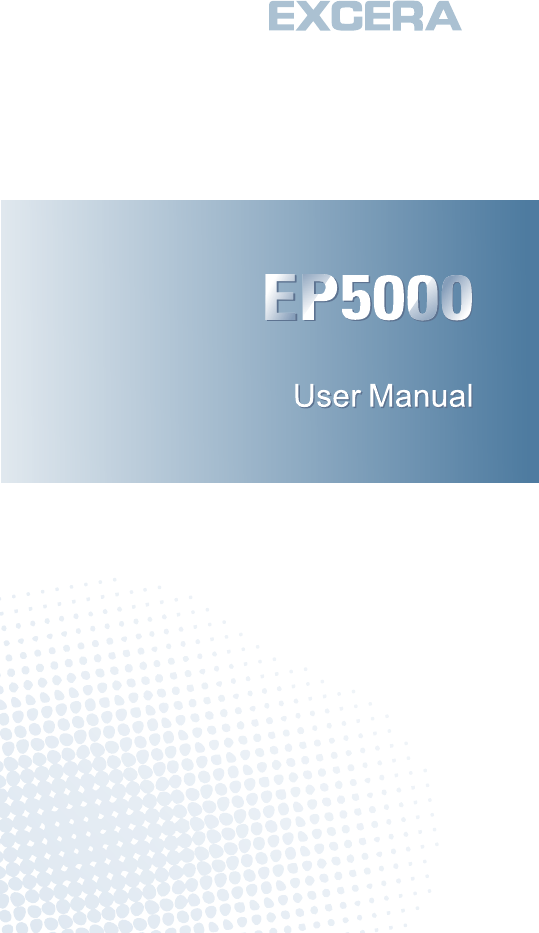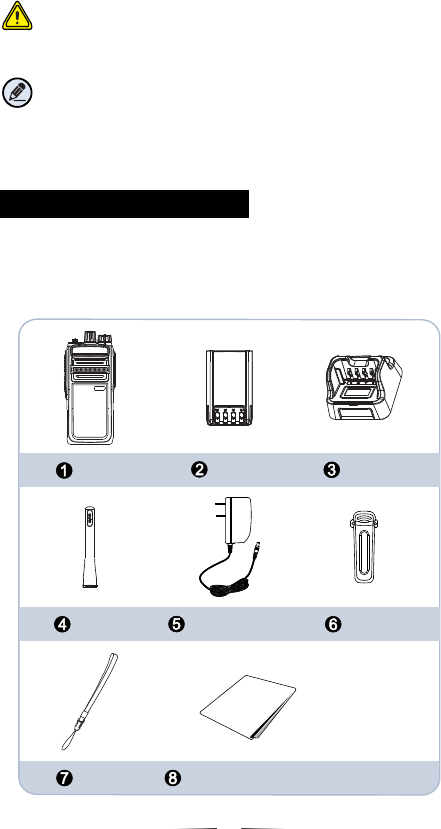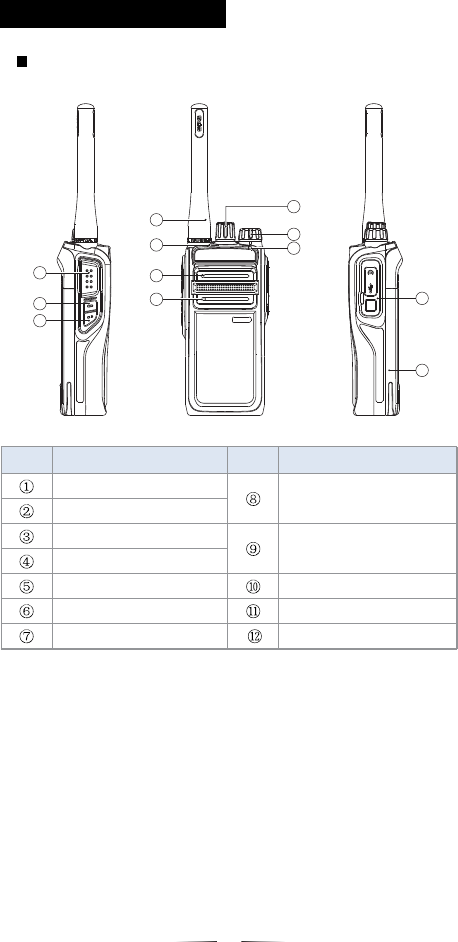Excera Technology EP5800U1 Digital Portable Radio User Manual
Shenzhen Excera Technology Co., Ltd. Digital Portable Radio
User manual

Digital Portable Radio
Digital Portable Radio

1
This manual helps you quickly get basic operations of our
digital portable radio.
Before using this product, please read this manual carefully.
Package Contents
Alert Icon
Caution:
Indicates situations that could cause human injury or
damage to your products.
Note:
Indicates tips that can help you make better use of
your products.
Please unpack carefully and check if all items listed
below are received. If any item is missing or damaged,
please contact your dealer.
Quick Reference
Guide
Radio Battery
Charger
Antenna
Power Adapter Belt Clip
Strap Quick Reference Guide

No. Part Name
PTT Key
Side Key 1 (SK1)
Side Key 2 (SK2)
Antenna
Top Key (TK)
Speaker
Microphone
No. Part Name
Getting Started
Radio Controls
Channel/
Group Selector Knob
Radio On-Off/
Volume Control Knob
Battery
Accessory Jack
2
11
12
1
2
3
6
7
4
5
9
10
8
LED Indicator

Radio Status Indication
3
LED Indicator
LED Indicator Radio Status
LED flashes green slowly.
LED flashes green rapidly.
LED glows green.
LED flashes red slowly.
LED flashes red rapidly.
LED glows red.
LED flashes orange slowly.
LED flashes orange rapidly.
None
Upgrading or powering on
Receiving
Low battery
None
Transmitting
Scanning
None
Turning the Radio On/Off
Basic Operations
Rotate the Radio On-Off/Volume Control knob clockwise or
counterclockwise until a click is heard to turn the radio on/off.
Adjusting Power Level
Adjusting the Volume
With this option, you may adjust power levels quickly. We
recommend you to adopt low power for battery saving. However,
if you cannot communicate with radios located at a distant place
with low power, please select high power.
You may press the programmed Adjust Power Level key to
adjust power levels.
After turning the radio on, rotate the Radio On-Off/Volume
Control knob clockwise to increase the call volume, or
counterclockwise to decrease it.

4
Selecting a Zone
A zone is a group of channels exhibiting the same property. The
radio supports 32 zones and each zone contains 128 channels
at most.
You can select a zone by pressing the programmed Zone Up or
Zone Down key, and you will hear the correspond warning tone
when switching to the zone.
Selecting a Channel
After turning the radio on, rotate the Channel Selector knob to
select a needed channel. You can also switch to the designated
channel by pressing the Preset Channel key.
If the Channel Notify function is active, you will hear the
corresponding channel number when switching to any channel.
Switching the Channel Mode
This radio can operate in either digital or analog conventional
mode.
Each channel can be programmed as either analog or digital
channel via the CPS. If the current zone includes a mixture of
analog and digital channels, you may quickly switch between
digital and analog through the Channel Selector knob.
Private Call
Call
A private call is a call form an individual radio to another
individual radio.
You can make a private call to the preset contact by pressing the
PTT key in standby status.
To ensure that your speech is clear, keep the microphone 2.5 to
5 cm from your mouth.
Note:
You may preset a contact for each digital channel.
The contact may be a private call contact, or group
call contact or all call contact.

5
Receive a Call or Call Back
When receiving a private call, you may answer the call without
any operation, and press the PTT key in preset time to call back.
A group call refers to a call from an individual radio to a group of
radios in standby status.
Group Call
Initiate a Call
You can make a group call to the preset contact by pressing the
PTT key in standby status.
Receive a Call or Call Back
When receiving a group call, you may answer the call without
any operation, and press the PTT key in preset time to call back.
To transmit a call on an analog channel, press the PTT key and
speak into the microphone.
To receive a call on an analog channel, release the PTT key.
Transmitting or Receiving a Call on Analog Channel
The purpose of Transmit Time-Out is to prevent any user from
occupying a channel for an extended period. If the preset time
expires, the radio will automatically terminate the transmission
and sound alert tones that will disappear when the PTT key is
released.
You may set the time via the CPS.
Transmit Time-Out


Major Technical Specification
PMR
Operation Frequency Range: From 400MHz to 470MHz
Modulation Type:
Analog: FM
Digital: 4FSK
Channel Separation:
Analog: 12.5kHz
Digital: 12.5kHz
Rated Output Power: High: 4.2W Low: 1.2W
Bluetooth
Version: Supported BT4.0 EDR+BLE
Modulation: GFSK, π/4DQPSK, 8DPSK
Operation frequency: 2402MHz~2480MHz
Channel number:
79 Channel for EDR
40 Channel for BLE
Channel separation:
1MHz for EDR
2MHz for BLE
FCC Statement
This device complies with Part 15 of the FCC Rules. Operation is subject to the following two conditions:
(1) This device may not cause harmful interference, and
(2) This device must accept any interference received, including interference that may cause undesired operation.
NOTE 1: This equipment has been tested and found to comply with the limits for a Class B digital device, pursuant to
part 15 of the FCC Rules. These limits are designed to provide reasonable protection against harmful interference in a
residential installation. This equipment generates, uses and can radiate radio frequency energy and, if not installed
and used in accordance with the instructions, installed and used in accordance with the instructions, may cause
harmful interference to radio communications. However, there is no guarantee that interference will not occur in a
particular installation. If this equipment does cause harmful interference to radio or television reception, which can be
determined by turning the equipment off and on, the user is encouraged to try to correct the interference by one or
more of the following measures:
- Reorient or relocate the receiving antenna.
- Increase the separation between the equipment and receiver.
-Connect the equipment into an outlet on a circuit different from that to which the receiver is connected.
-Consult the dealer or an experienced radio/TV technician for help.
NOTE 2: Any changes or modifications to this unit not expressly approved by the party responsible for compliance
could void the user's authority to operate the equipment.
Warning!
This portable radio generates RF electromagnetic energy during transmit mode. This radio is designed for and
classified as “Occupational Use Only,” meaning it must be used only during the course of employment by individuals
aware of the hazards and the ways to minimize such hazards. This radio is NOT intended for use by the “General
Population” in an uncontrolled environment.
Output power listed is rated conducted. This device must be restricted to work-related operations only in an
Occupational/Controlled RF exposure environment and must operate with a duty factor not exceeding 50%. This
transmitter may operate with the antenna(s) documented in this filing in Push-to-Talk and body-worn configurations.
RF exposure compliance is limited to the specific belt-clip and accessory configurations as documented in this filing
and the separation distance between user and the device or its antenna shall be at least 2.5 cm. All qualified
end-users of this device must have the knowledge to control their exposure conditions and/or duration to comply with
occupational/controlled Exposure limit and requirements. The highest reported SAR values for Face-held and
body-worn are 2.705 W/Kg and 2.856 W/Kg.